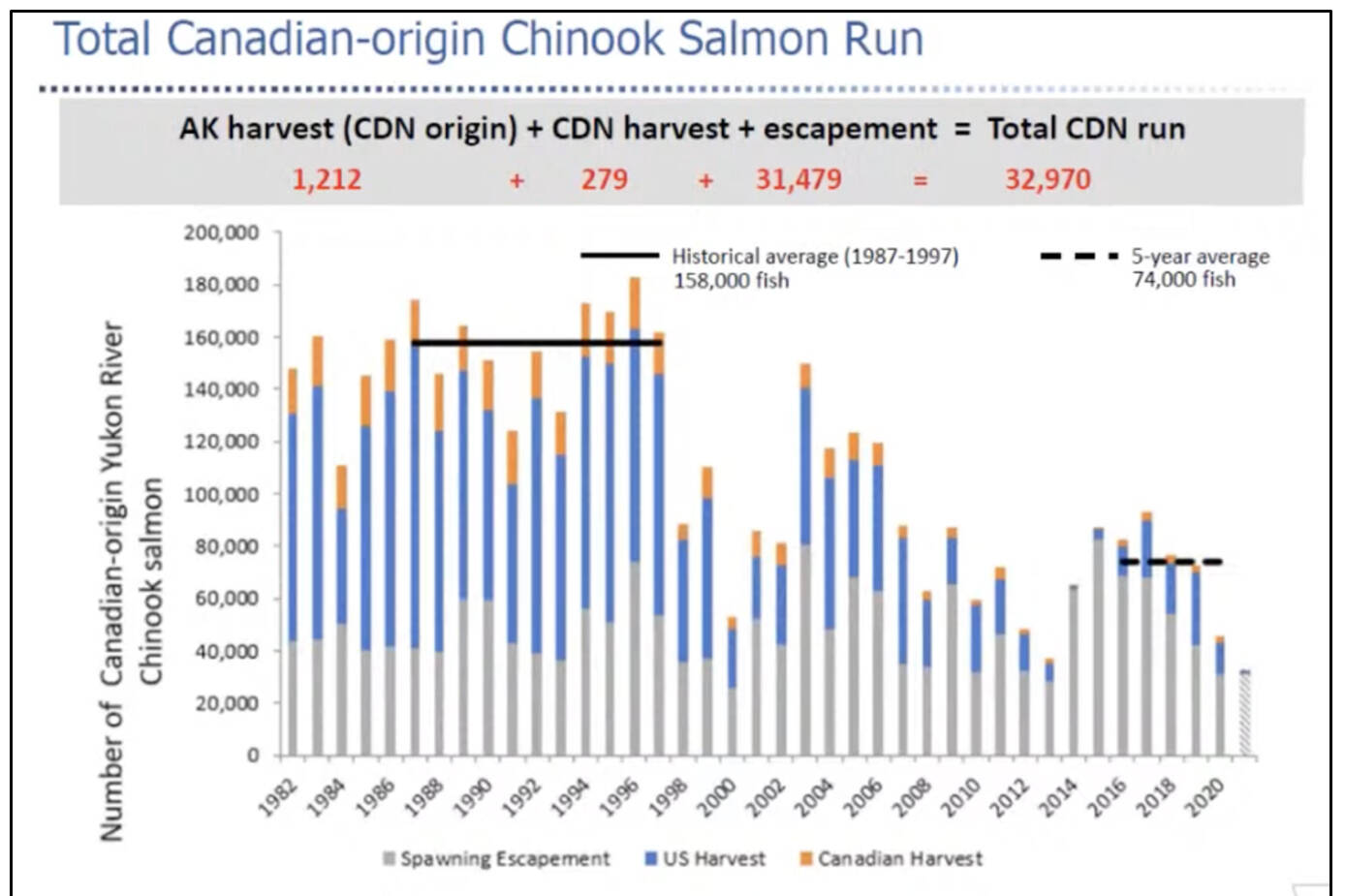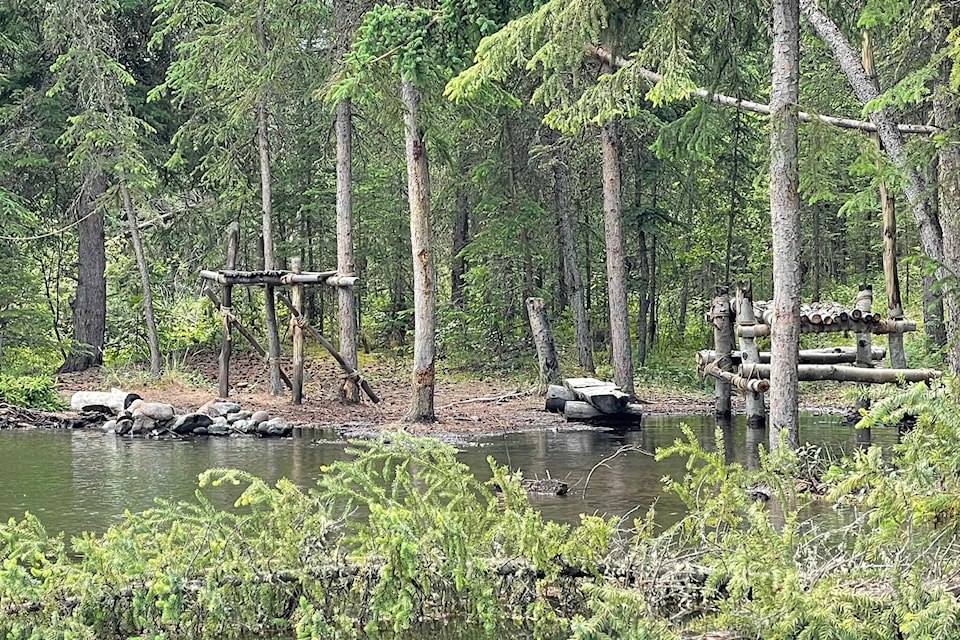It looks as if the devastating outlook for Yukon River salmon will continue.
Elizabeth MacDonald, manager of fisheries at the Council of Yukon First Nations, says it has been a slow and steady decline.
No commercial licenses have been issued for the past two years. Last year, the federal minister of fisheries shut down most commercial licences in B.C.; the Yukon Salmon Sub-Committee asked fishers to not harvest Chinook; and Alaska closed all their salmon fisheries in the coastal areas and in the Yukon River.
The international Yukon River Salmon Panel met January 25 to 27 and discussed the decline.
The recent meeting between Alaska and Yukon delegates provided few, if any bright spots for the salmon. Their numbers have sunk to record lows.
And although the numbers of actual fish aren’t everything, it’s actually worse when the fish counts are examined more specifically for size, sex, age, and fertility rates.
The numbers are down, coupled with younger fish which are smaller. The percentage of five- and six-year-olds is dropping, so that the most common are the three- and four-year-olds, which are smaller (less food per fish), less fertile (fewer eggs per fish), and less likely to survive the challenging swim to spawn.
This means you have to find ways for more fish reach their spawning grounds, MacDonald explained. The panel needs to predict how many fish are needed to spawn to successfully, so enough fry can return to ocean and then come back again.
More frequently, that goal is seldom met. All three Yukon River salmon — chinook, coho and chum — continue their downward trend for the last three years and are now at an all-time low.

What’s in store for 2022?
MacDonald says, “Everyone’s hopeful, salmon do fluctuate, they go up and down. Problem is that we’re seeing is they just tend to be more at the bottom end of the range for the last decade. And we’d like to see that change.”
But no one really knows until this year’s salmon reach Eagle, Alaska, six months from now.
The chart was one of the slides prepared as part of the 2021 season data review. It goes back to 1982. The five-year average is half of the 10-year average, in half the time; and the last two years are significantly lower than that.
It shows that the total Canadian-origin run of Chinook salmon is 32,970, which is far below the recent five-year average of 74,000 fish.
With the decline in the number of fish, so disappears a way of life along the river that used to thrive.
Life on the river once meant food for the winter, and for some, a livelihood. First Nations families would spend their summers at fish camps dotted along the river and be able to feed their extended families through the winter — but not anymore. Once, commercial fishers could make a living — not any more.
Harvesting of salmon in the Yukon River has been going on for millennium. 1982 is only a relevant baseline for the last 50 years. Camps once lined the Yukon River and its tributaries from Eagle Alaska to Marsh Lake, but only a few remain active now. Fish were integral to established gathering places where groups from different areas would come together for harvest and to share stories.
The Whitehorse hydro dam was completed in 1958.
The Kwanlin Dün First Nation, in their book Our Story in Our Words, describe how the Whitehorse dam changed everything. The dam “blocked the upriver migration of two salmon runs to Marsh Lake.”
The dam was completed two years before the fish ladder was built.
“Tens of thousands of fish died, despite efforts by our people to transport them above the dam in gunnysacks and trucks, and many families went hungry. The runs have still not returned to their pre-dam levels.”
The dam altered the subsistence gathering patterns of the Tagish Kwan, the Daḵká Kwa’an and the Kwanlin Dün people. Residences, cabins and fish camps along the Whitehorse rapids were dismantled, gatherings at M’Clintock stopped, and many people dispersed to Fish Lake and Whitehorse.
In 2020, researcher William Twardek found that only 200 fish made it through the fish ladder and to the Yukon River system beyond. Teslin people have not fished for over 20 years.
But many factors are responsible for the salmon’s decline.
The Yukon River Panel is a 12-person body with six panel members each from the United States and Canada, representing the interests of Yukon River fishers, First Nations, tribal councils, fisheries managers and others who depend upon salmon for subsistence, cultural, commercial or recreational purposes.
MacDonald says that the panel was developed many years after the Pacific Salmon Treaty and does not report to the treaty’s committees and sub-communities. It is autonomous and flexible, and closely connected to the people of the river, as opposed to the membership on the other international bodies.
The recent meeting was an update on what happened. Its’ next meeting in April will be about predictions and targets in another attempt to preserve what’s left of a diminishing species.
READ MORE: Yukon salmon runs facing difficulty again
— With files from Haley Ritchie
Contact Lawrie Crawford at lawrie.crawford@yukon-news.com
